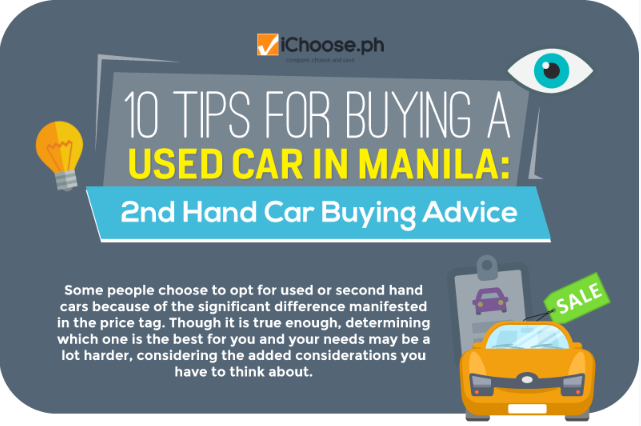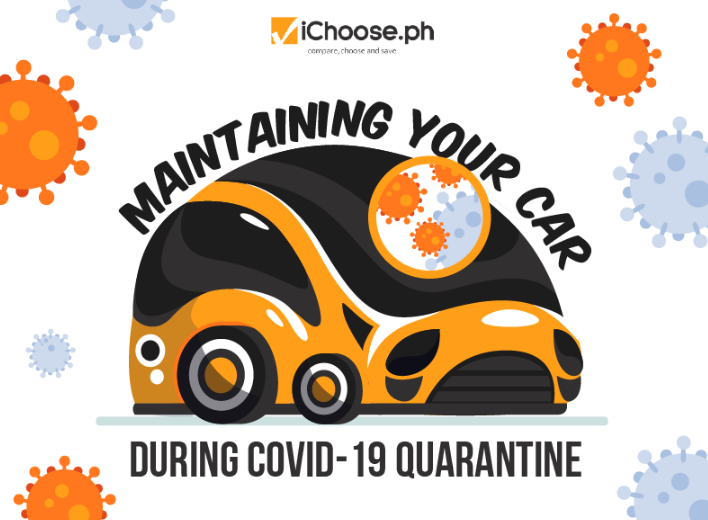10 Tips for Buying A Used Car in Manila: 2nd Hand Car Buying Advice [Infographic]
Some people choose to opt for used or second-hand cars because of the significant difference manifested in the price tag. Though it is true enough, determining which one is the best for you and your needs may be a lot harder, considering the added considerations you have to think about. After all, buying a used car can be a minefield—one mistake and you bought yourself a scrap on wheels.
Through ample research and inspection, car buyers can really make the most out of the deals. By reading articles about cars, engines, and everything you have to know about used cars, you will know what to look for—especially the deal breakers you can spot.
Here is how you win the deal and select the best-used car for you.
- Set Your Budget.
Why setting the budget should be the first thing you do? To narrow down your options. There are a lot of second-hand cars available in the market, and if you don’t have any filters to limit it, then you may never find the one that is perfect for you, your needs and your personality. Setting the budget is also one way of setting your expectations for the types of used vehicles you can purchase.
It is essential that you set a realistic budget, considering the amount you can spend and the amount you should spend. Remember, just because you can afford it doesn’t mean it’s the perfect choice for you.
As a baseline, it is suggested that you spend no more than 20% of your monthly net income on a monthly-based payment scheme for the car. But of course, this ‘rule’ doesn’t and should not apply to everyone. Each has a different set of monthly expenditures that should be considered and prioritized such as:
- Rent or mortgage.
- Utilities.
- Groceries.
- Phone and Internet bills.
- Student loans/other debts.
- Consider the ‘Hidden Costs’.
Setting a budget should not only revolve on the price tag of the used car. As a buyer, you should be aware and knowledgeable about the hidden costs that come with it. You should remember that buying a used car entails more than paying for the vehicle itself. There will be costs associated with your used car other than your monthly auto payment, such as:
- Your car insurance rate.
- Various taxes and fees.
- Your car’s depreciation rate.
- Gas, oil changes, and other maintenance needs.
Don’t forget to keep these factors in mind when setting and determining your used car budget. Once you have considered these factors and determined your monthly allowable expense, then you’re on your way to choose which type of car within that price range will be the best option for you.
- Do some research.
By doing initial research, you will know what to look for, or which ones to stay away from. Read on articles that discuss what a great car should feel like and look like. Ask your friends who owned cars about their experiences. Gather a network and filter your options.
Researching will open a lot of doors for you—from websites, you can check out cars from, or new things to learn about used cars, how to take care of them, and this: how to win the deal.
- Don’t buy on impulse.
Never buy something just because you loved it the first time. Take the time to think it through before arriving at a decision.
Buying on an impulse may lead you to decide that you’re going to buy the vehicle before you’ve looked at it, and that makes you do things like inspecting the vehicle in the dark and/or in the rain, where you’re not going to look at or see certain things.
- Get to know the previous owners.
Talking to the previous owners may clarify a lot of things which can help you decide. Why did they decide to sell their car? Is the owner one to neglect maintenance? Is the owner eager to sell the car or not willing to sell it at all?
Sometimes learning about the owner can tell you a lot about the car, as well as the kind of care you should provide for it if in case you decide to buy theirs.
- Don’t settle with the first car you see.
Remember, you will not run out of options. There are a lot of used cars in the market and you should never buy the first car you see—unless you really like it and you think it’s a good deal.
- Ask for the service records
It is a must to have the service records when you purchase a used car. In fact, these documents should be part of the deal. These records will serve as your guide and reference regarding the state of the vehicle you will purchase. Service records can be a collection of receipts or reports from machine shops and mechanics.
- Test drive.
Experts suggest that more than taking it for a short drive around the neighborhood to get a feel to it, you can also do some simple tests that can reveal possible hidden issues in the engine. For example, you can turn the steering at full lock left and right, and listen for knocking/tugging sounds; these indicate problems with the steering. Moreover, you can do a brief, full-throttle acceleration and listen to the engine and transmission for strange noises. Do a simulated-panic stop to see how well the brakes work, or if the car tends to steer to the left or right.
If there are issues, list them down and think about it: do you still want the car? Was it reasonably priced? Are you willing to fix these problems?
- Consider the seller’s character.
When you meet up with your potential dealers, you should think ahead and analyze their disposition. Is the person unusually eager to sell you his car already, or quite cool about the whole thing, and possibly even reluctant? Why are they selling it in the first place? Are they trying too hard to make a sale? One good trick is to ask about the car’s service history and look for consistency in his answers.
- Inspect the vehicle thoroughly.
It would be best to check the car in daylight so you can see the paint quality, possible damages on the dashboard, fading of tints, deteriorating interiors, and seat covers. Sometimes, small spots that don’t quite match the other panels are a clue that it has been bent, scratched, touched up with body filler or putty, and painted over—can be a great way to get a bargain. Check the engine bay and look for signs of filler; this is a clue that the car has been involved in a front-end collision which is always a sign that it will not be worth it. Test the A/C at both its lowest and highest settings, and see how long it takes to cool the vehicle. See if the wipers and windshield washer work, too.
More useful reads from iChoose.ph







